METZ, FRANCE
Sablon Railway
Yards
Uncle Raoul
and the Soldier-Railroaders continued their work in the
Aulnoye sector for a few months until orders came down for the 716th to depart for Metz, France. On February 7, 1945,
The Battalion received orders to transfer to the Metz
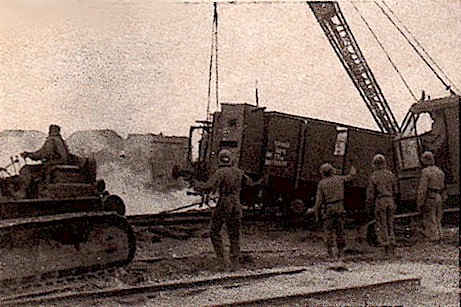 area
of operations. The men of the 716th including
area
of operations. The men of the 716th including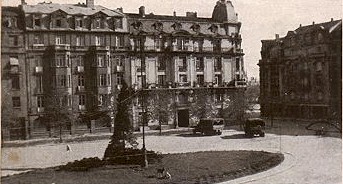 Uncle Raoul's "A"
Company loaded into
two hundred and twenty-five 40 and 8's and arrived the next day at Metz. Along with the 716th,
an DS detachment of 100 men and officers from "D" Company 746th
Railway Operating Battalion, a Signal platoon of the 717th Railway Operating
battalion, and a French Engineer company the 5/9 were sent to the Metz area and
fell under the 716th's control. The first problem the 716th encountered
was finding suitable place to billet the men. A former Seminary was chosen, one
that could house five-hundred men, but it was in dire need of repair. The men of
"A" Company sprang into action and after borrowing some pumps from the
engineers pumped out the water from the basement. This evolution took five days.
Then they repaired the faulty wiring, broken steam lines, ruptured waterlines,
and fixed the heat radiators. Soon the buildings were in habitable condition.
After the housing issue was resolved, the company began their greatest challenge yet to date: The yards at Sablon. The Metz-Sablon yards were one of the major
Uncle Raoul's "A"
Company loaded into
two hundred and twenty-five 40 and 8's and arrived the next day at Metz. Along with the 716th,
an DS detachment of 100 men and officers from "D" Company 746th
Railway Operating Battalion, a Signal platoon of the 717th Railway Operating
battalion, and a French Engineer company the 5/9 were sent to the Metz area and
fell under the 716th's control. The first problem the 716th encountered
was finding suitable place to billet the men. A former Seminary was chosen, one
that could house five-hundred men, but it was in dire need of repair. The men of
"A" Company sprang into action and after borrowing some pumps from the
engineers pumped out the water from the basement. This evolution took five days.
Then they repaired the faulty wiring, broken steam lines, ruptured waterlines,
and fixed the heat radiators. Soon the buildings were in habitable condition.
After the housing issue was resolved, the company began their greatest challenge yet to date: The yards at Sablon. The Metz-Sablon yards were one of the major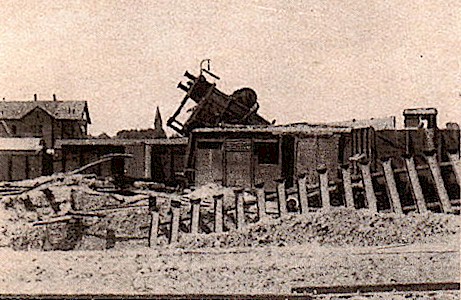 installations in France. As a result the yards were targets of numerous Allied bombing missions during the previous months when the Germans occupied the city. When the battalion arrived in Metz , Sablon was completely destroyed. The yards were a shambles of wrecked cars, twisted and destroyed track, demolished buildings, and destroyed equipment. The situation was critical, the army needed the yards to be restored in short time in order to get badly need supplies to the front for the spring offensive across the Rhine.
The French estimated that it would take four months to repair the damage and
restore rail traffic. The 716th thought otherwise. Working twelve hour shifts,
the B&B and Trackmen worked non-stop to clear the yard. Assisting them
were
three cranes, five
installations in France. As a result the yards were targets of numerous Allied bombing missions during the previous months when the Germans occupied the city. When the battalion arrived in Metz , Sablon was completely destroyed. The yards were a shambles of wrecked cars, twisted and destroyed track, demolished buildings, and destroyed equipment. The situation was critical, the army needed the yards to be restored in short time in order to get badly need supplies to the front for the spring offensive across the Rhine.
The French estimated that it would take four months to repair the damage and
restore rail traffic. The 716th thought otherwise. Working twelve hour shifts,
the B&B and Trackmen worked non-stop to clear the yard. Assisting them
were
three cranes, five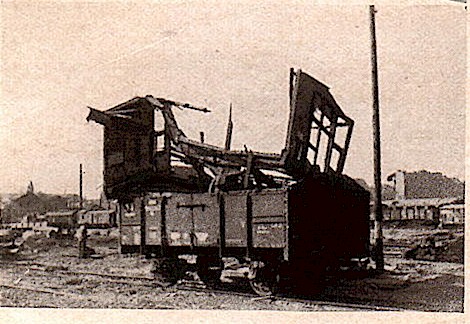 bulldozers, along with help from "B" Company,
the 718th ROB Wrecking Crane Crew, and the 245 men of the 5/9 French
Engineers. The men proceeded to clear the yard of
wrecked cars and debris. A total of 400 cars were removed from the yard, along with some 25 large bomb craters filled in, and 45
damaged tracks repaired. The 716th's
Herculean efforts enabled the yard to be operational within a month. Three months ahead of when it was thought it could be operational again, using
one-sixth the man power estimated by the French. After the yard at Sablon was
repaired, the force was moved to the yard at Montigny. At Montigny the men
of the 716th a heavy repair shop was established and the men of "B"
Company began repairing damaged cars at a rate of eight per day.
bulldozers, along with help from "B" Company,
the 718th ROB Wrecking Crane Crew, and the 245 men of the 5/9 French
Engineers. The men proceeded to clear the yard of
wrecked cars and debris. A total of 400 cars were removed from the yard, along with some 25 large bomb craters filled in, and 45
damaged tracks repaired. The 716th's
Herculean efforts enabled the yard to be operational within a month. Three months ahead of when it was thought it could be operational again, using
one-sixth the man power estimated by the French. After the yard at Sablon was
repaired, the force was moved to the yard at Montigny. At Montigny the men
of the 716th a heavy repair shop was established and the men of "B"
Company began repairing damaged cars at a rate of eight per day.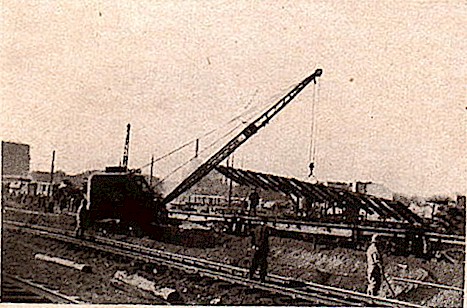 Meanwhile the
"A" Company's Bridge and Building Platoon repaired numerous damaged and destroyed bridges
along the 716th's area of responsibility. Whenever a bridge was too badly
damaged to be repair the B&B men replaced it with a new one. In the loop in
the Metz Area the B&B men replaced four bridges just in time to get the
badly needed supplies to the front. The Trackmen of the "Gandy Dancer"
Platoon converted thirteen miles of single track into double track. To
complicate matters a saboteur dynamited the entrance to one of the tunnels on
the route. Hundreds of tons of earth and rock blocked about 100 feet of the
entrance to tunnel. After working around the clock the men of "A"
Company cleared the obstruction in record time. The Signalmen installed and
reconstructed a dispatchers line in Metz, along with similar dispatch lines in
Metz-Audun le Roman, Conflans, Arnaville, and Courcelles.
Meanwhile the
"A" Company's Bridge and Building Platoon repaired numerous damaged and destroyed bridges
along the 716th's area of responsibility. Whenever a bridge was too badly
damaged to be repair the B&B men replaced it with a new one. In the loop in
the Metz Area the B&B men replaced four bridges just in time to get the
badly needed supplies to the front. The Trackmen of the "Gandy Dancer"
Platoon converted thirteen miles of single track into double track. To
complicate matters a saboteur dynamited the entrance to one of the tunnels on
the route. Hundreds of tons of earth and rock blocked about 100 feet of the
entrance to tunnel. After working around the clock the men of "A"
Company cleared the obstruction in record time. The Signalmen installed and
reconstructed a dispatchers line in Metz, along with similar dispatch lines in
Metz-Audun le Roman, Conflans, Arnaville, and Courcelles.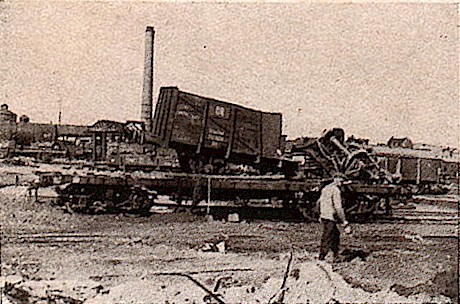 In addition a 50 Drop
and a 10 Drop Switchboard were installed in the Headquarters. In what
became known as the Spider-web of Metz, Detached
Service (DS) men were dispersrsed to Audun le Roman, Bouzonville,
Hartgarten-Falck, Thionville, Friestoff and other cities. They were staffed with
"A" Company personnel in order to carry on
Construction and Maintenance work. Back in Metz the Engineering section
built a first class office for the headquarters. However the men soon
realized that improvements to the office increased the workload. So before long
the men split the day up into two shifts in
order to handle all of the work. B Company meanwhile set up operations on the outskirts of town at the Frescaty Roundhouse. The mechanics and machinists returned to their shop cars and set up for business on a siding at Metz.
In addition a 50 Drop
and a 10 Drop Switchboard were installed in the Headquarters. In what
became known as the Spider-web of Metz, Detached
Service (DS) men were dispersrsed to Audun le Roman, Bouzonville,
Hartgarten-Falck, Thionville, Friestoff and other cities. They were staffed with
"A" Company personnel in order to carry on
Construction and Maintenance work. Back in Metz the Engineering section
built a first class office for the headquarters. However the men soon
realized that improvements to the office increased the workload. So before long
the men split the day up into two shifts in
order to handle all of the work. B Company meanwhile set up operations on the outskirts of town at the Frescaty Roundhouse. The mechanics and machinists returned to their shop cars and set up for business on a siding at Metz.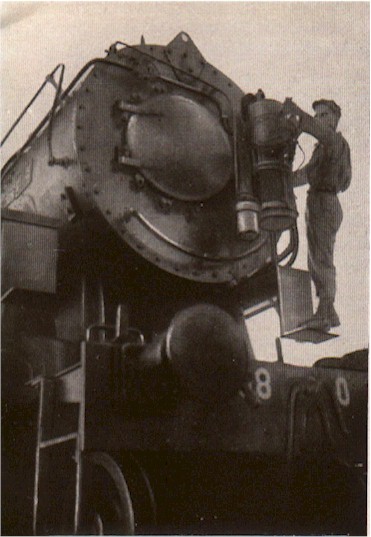 Due to the bombing all five roundhouses at Sablon had been destroyed along with their trackage, turntables, gantry cranes, and watering facilities. The nearest undamaged roundhouse was at Frescaty about two miles from Sablon. Machine tools and equipment were badly needed at Frescaty to handle the volume of work there. Due to the distance from Sablon it was soon necessary for the 716th to expedite the repairs of the yards. So the soldier-railroaders of B Company set up a servicing operation at one of the recently repaired roundhouses at Sablon while the heavy repair work remained at Frescaty. The Car platoon set up operations at the Montigny Car Shops, a major repair facility of the SNCF. Montigny had been one of the SNCF's major repair and manufacture facilities for the region. The Allied bombers had completely destroyed the plant there and it was up to the men of the 716th to repair and restore the facility as best they could with the help of the French. The 716th and the French devised a plan of repairing and restoring one building at a time while small repair operations
Due to the bombing all five roundhouses at Sablon had been destroyed along with their trackage, turntables, gantry cranes, and watering facilities. The nearest undamaged roundhouse was at Frescaty about two miles from Sablon. Machine tools and equipment were badly needed at Frescaty to handle the volume of work there. Due to the distance from Sablon it was soon necessary for the 716th to expedite the repairs of the yards. So the soldier-railroaders of B Company set up a servicing operation at one of the recently repaired roundhouses at Sablon while the heavy repair work remained at Frescaty. The Car platoon set up operations at the Montigny Car Shops, a major repair facility of the SNCF. Montigny had been one of the SNCF's major repair and manufacture facilities for the region. The Allied bombers had completely destroyed the plant there and it was up to the men of the 716th to repair and restore the facility as best they could with the help of the French. The 716th and the French devised a plan of repairing and restoring one building at a time while small repair operations
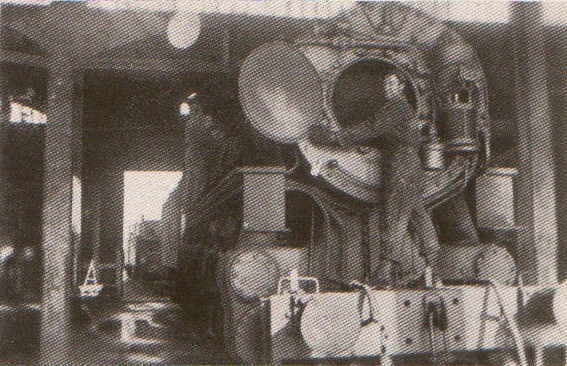 continued, the main focus would be to restore the plant to operational status. The remaining Car Men when not working at Montigny remained busy assisting A Company in the removal of the 400 some odd cars destroyed at Sablon. After operations had stabilized at Metz, it became necessary to send men out to Detached Service (DS). Detachments were sent to Audon-le-Roman to set up for locomotive servicing and car inspections. Soon the volume of traffic shifted and it became necessary for the men to set up operations at
Thionville. Thionville was also heavily damaged during the bombing raids. Rather than repair the facility the men set up for business outside of the roundhouse on lead, and storage tracks. From 5-8 April B Company operated the roundhouse at Hargarten-Falck until they were relieved by the railroaders of the 732nd ROB. C Company meanwhile was busy, scattered throughout the Metz area. DS detachments were located at the junction points of Audon Le Roman and Longuyon on the main line from Sedan to Aulnoye. Landres and Mancieulles were set up as a
continued, the main focus would be to restore the plant to operational status. The remaining Car Men when not working at Montigny remained busy assisting A Company in the removal of the 400 some odd cars destroyed at Sablon. After operations had stabilized at Metz, it became necessary to send men out to Detached Service (DS). Detachments were sent to Audon-le-Roman to set up for locomotive servicing and car inspections. Soon the volume of traffic shifted and it became necessary for the men to set up operations at
Thionville. Thionville was also heavily damaged during the bombing raids. Rather than repair the facility the men set up for business outside of the roundhouse on lead, and storage tracks. From 5-8 April B Company operated the roundhouse at Hargarten-Falck until they were relieved by the railroaders of the 732nd ROB. C Company meanwhile was busy, scattered throughout the Metz area. DS detachments were located at the junction points of Audon Le Roman and Longuyon on the main line from Sedan to Aulnoye. Landres and Mancieulles were set up as a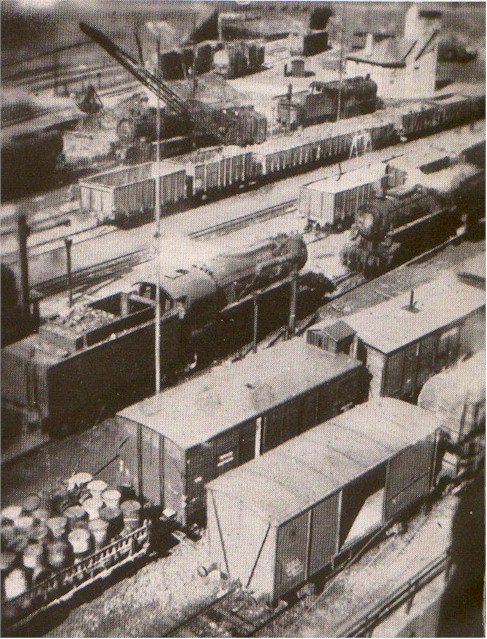 Petroleum, Oil, and Lubricant dump or POL. A detachment was sent to Florange as a classification yard. Other DS personnel went to Arnaville, Conflans, Thionville, and
Hargarten-Falck. While battalion HQ was set up at Metz, the center of the operations at Metz were really at Thionville, where the city served as the center of the web of rails that covered the entire region.
Petroleum, Oil, and Lubricant dump or POL. A detachment was sent to Florange as a classification yard. Other DS personnel went to Arnaville, Conflans, Thionville, and
Hargarten-Falck. While battalion HQ was set up at Metz, the center of the operations at Metz were really at Thionville, where the city served as the center of the web of rails that covered the entire region.
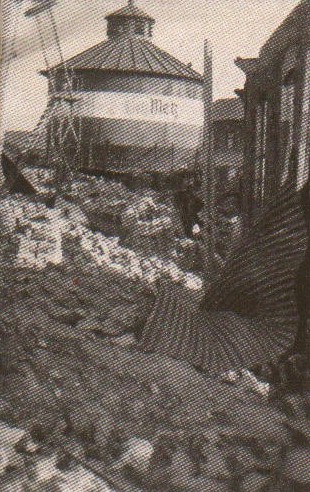 Thionville, known by the Germans as Diedenhofen, was in the center of the Alsace-Lorraine territory. Hotly disputed over the years between Germany and France, the territory had changed hands several times during the previous 75 years, a large portion of the population was German as well as French. The Former having again acquired the territory in 1940, resettled the area with Germans. The French were reluctant to work in this area due to the prevalence of so many Germans. So the responsibility fell to the GI's of the 716th. While working in this newly liberated area, the men located a vast assortment of rail cars. Hundreds and hundreds of cars of every assortment were found. The Germans had used them when they fled France in the late summer and early fall of 1944. Now it was up to the boys from C Company to round them up and get them back to France where there was a severe shortage of rolling stock. When this was finished the month closed out with the boys working their routes in anticipation of the end of the war. All the news reports from the front had been very good and the Nazi's were finished. By the beginning of May the war was almost over and the men soon found themselves enroute to their next destination: Germany!
Thionville, known by the Germans as Diedenhofen, was in the center of the Alsace-Lorraine territory. Hotly disputed over the years between Germany and France, the territory had changed hands several times during the previous 75 years, a large portion of the population was German as well as French. The Former having again acquired the territory in 1940, resettled the area with Germans. The French were reluctant to work in this area due to the prevalence of so many Germans. So the responsibility fell to the GI's of the 716th. While working in this newly liberated area, the men located a vast assortment of rail cars. Hundreds and hundreds of cars of every assortment were found. The Germans had used them when they fled France in the late summer and early fall of 1944. Now it was up to the boys from C Company to round them up and get them back to France where there was a severe shortage of rolling stock. When this was finished the month closed out with the boys working their routes in anticipation of the end of the war. All the news reports from the front had been very good and the Nazi's were finished. By the beginning of May the war was almost over and the men soon found themselves enroute to their next destination: Germany!
 CENTRAL
EUROPE: Occupation and Transfer to the 732nd and 744th ROB
CENTRAL
EUROPE: Occupation and Transfer to the 732nd and 744th ROB  RAOUL
SANTOS: Homepage
RAOUL
SANTOS: Homepage They
Served with Honor: Home page
They
Served with Honor: Home page